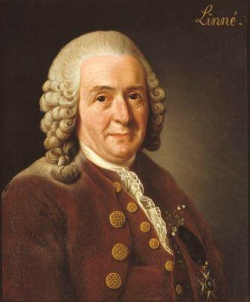Carl Linnaeus

- Born
- 23 June 1707
- Died
- 10 January 1778 (age 70)
Carl Linnaeus developed a way to classify and name all the living things on earth, in a system known as taxonomy, and this system is still used by scientists today. Taxonomy is the science of identifying and naming living organisms such as plants, animals, bacteria and fungi. Linnaeus also identified ecology as a distinct area and was one of the first people to describe food chains.
Linnaeus was the son of a country parson in southern Sweden. He was interested in plants and flowers as a young boy, had his own garden by the age of five and by the age of eight was nicknamed ‘the little botanist’. His father taught him the names of the plants and Linnaeus worked hard to remember them. This was no small achievement at the time, as their Latin names were very long. The tomato’s Latin name was Solanum caule inermi herbaceo, foliis pinnatis incisis, racemis simplicibus.
Linnaeus went to university to study medicine, which at the time was based on herbalism. At the University of Uppsala he came to the attention of Olaf Celsius, who was very impressed that the young Linnaeus knew the names of so many plants. Linnaeus had little money and Celsius offered him somewhere to live and the use of his library.
It was here that Linnaeus developed his theory of plant sexuality, which later helped him to create the system of plant classification. This led to his appointment as Director of Botany by Olof Rudbeck.
At that time, many new plants were being discovered and Linnaeus realised that the existing methods of classification were not suitable to deal with the new discoveries. In 1735, he published an 11 page pamphlet, Systema Naturae, which outlined his new way to classify the natural world. Five years later, he did the same with animals. He developed the system over the next 23 years until a two-volume edition was published in 1758. By the time of his death in 1778, Linnaeus had named 12,000 species of plants and animals.
In this new system, Linnaeus decided that groups should be divided into those that shared certain physical characteristics. The highest grouping was plants, animals and minerals, known as kingdoms. There were then divisions below that, of class, order, genus and species. Linnaeus gave each known plant a Latin name in two parts, known as a binomial – genus followed by species. This approach shortened the name of the tomato to Solanum lycopersicum.
Not only is Linnaeus considered the “Father of Taxonomy”, he was also a pioneer in the study of ecology. He was one of the first to describe relationships between living things and their environments.
Linnean Society
The binomial system has become the standard way of naming things and has made it easier to describe plants, animals and minerals.
During the 1730s, Linnaeus also travelled widely, including a visit to England in 1736, where he met the then president of the Royal Society, Sir Hans Sloane,.and Philip Miler, Superintendent of the Society of Apothecaries garden, which is now known as the Chelsea Physic Garden.
The Linnean Society was founded in 1788. It has housed his botanical, zoological and library collections since 1829, which are a primary reference for taxonomy. To this day, the Society provides a place for the discussion and advancement of the life sciences. It publishes three international journals and awards prizes for outstanding work in natural history and published botanical illustrations.



